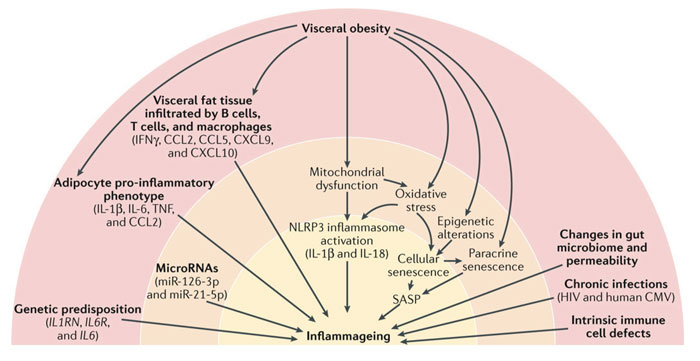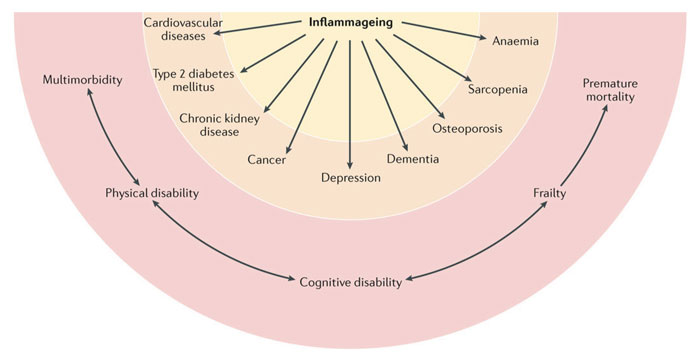
AGING and ADIPOSE TISSUE

Metabolic alterations in the aging process
Aging is a process that is accompanied by anatomical and structural changes that affect the functionality of organs and tissues. It follows a functional decline of the individual and the onset of a condition of fragility.
It is easy to see how a person, as the age progresses, tends to gain weight (abdominal level for men, hips for women). This is associated with a physiological decrease in muscle mass and strength (up to a possible condition of sarcopenia), also due to the absence of regular physical activity. Overall, in the 45-65 age group, an increase in the fat body mas /lean body mass ratio, combined with a subsequent redistribution of adipose tissue in ectopic sites (where it is usually not present) and its progressive dysfunction, represents a factor of risk for metabolic alterations and chronic low-grade inflammation.
The transformations in the adipose tissue
Due to its central role in metabolism and inflammatory conditions, the progressive malfunction of adipose tissue is a characteristic element of the aging process. Physiologically, as we age, adipose tissue goes through the following changes:
- reduced formation of new functional adipocytes (adipose tissue cells)
The molecular mechanisms are not exactly known, but adipose tissue progressively loses the ability to form perfectly functioning adipocytes starting from stem progenitors. The so-called MAD cells are formed that is, incompletely formed adipocytes that have little tolerance for the management of fatty acids and the intracellular accumulation of triglycerides. They remain smaller, are less responsive to insulin and promote a state of tissue inflammation, leading to an amplification of their formation process.
- redistribution of body fat to other tissues
The progressive loss of the ability of the adipocyte cell to store triglycerides in elderly individuals generates the release into the circulation of fatty acids which are thus stored in other organs. The so-called ectopic fat is formed with the accumulation of intracellular triglycerides in the pancreas, muscle, heart, kidneys and liver. This same fat (in the ectopic site) has the characteristics of visceral adipose tissue and, similarly to it, contributes to an increased risk of the onset of metabolic syndrome, type II diabetes, hypertension, atherosclerosis and other relevant clinical consequences.
- redistribuzione del grasso corporeo in altri tessuti
La progressiva perdita della capacità di immagazzinare trigliceridi da parte della cellula adipocitaria in individui anziani genera la liberazione in circolo di acidi grassi che vengono così immagazzinati in altri organi. Si forma il cosiddetto grasso ectopico con l’accumulo di trigliceridi intracellulari in pancreas, muscolo, cuore, reni e fegato. Questo stesso grasso (in sede ectopica) ha le caratteristiche del tessuto adiposo viscerale e, analogamente ad esso, contribuisce ad un aumentato rischio di insorgenza di sindrome metabolica, diabete di tipo II, ipertensione, aterosclerosi e altre conseguenze cliniche rilevanti.
- accumulation of senescent cells
As cells age or receive stress signals (also typical of the “aging” condition), they experience a process called senescence. Cellular senescence is a state in which cells are no longer able to proliferate. In adipocytes, senescence induces cell metabolism malfunction, helping to increase adipocyte dysfunction and tissue inflammation.
- tissue inflammation
Senescent pre-adipocytes and MAD cells produce proinflammatory cytokines that recruit innate and acquired immunity cells which, in turn, favor a state of tissue inflammation, worsen insulin sensitivity and the function of already dysfunctional adipocytes.

Image taken from: Ferrucci L, Fabbri E. Inflammageing: chronic inflammation in ageing, cardiovascular disease, and frailty. Nat Rev Cardiol. 2018 Sep;15(9):505-522. doi: 10.1038/s41569-018-0064-2. PMID: 30065258; PMCID: PMC6146930.
Inflammageing
Similarly to obesity, aging is a condition that promotes the development of metabolic dysfunctions related to a malfunction of the adipose tissue.
Adipocyte dysfunction during aging can derive both from oxidative stress, but also from a situation of chronic inflammation.
For this reason, the word inflammageing [1] was coined to highlight the link between inflammation and aging. From this point of view, the dysfunction of the adipose tissue begin to establish an important role in the study of the pathophysiology of aging and in the onset of metabolic and degenerative pathologies associated with it.

Image taken from: Ferrucci L, Fabbri E. Inflammageing: chronic inflammation in ageing, cardiovascular disease, and frailty. Nat Rev Cardiol. 2018 Sep;15(9):505-522. doi: 10.1038/s41569-018-0064-2. PMID: 30065258; PMCID: PMC6146930.
[1] Franceschi, C. et al. Inflamm-aging. An evolutionary perspective on immunosenescence. Ann. NY Acad. Sci. 908, 244-254 (2000)
https://www.lipinutragen.it/en/way-to-longevity/
https://www.lipinutragen.it/la-nutrizione-molecolare-nellanziano
- On 1 October 2021



